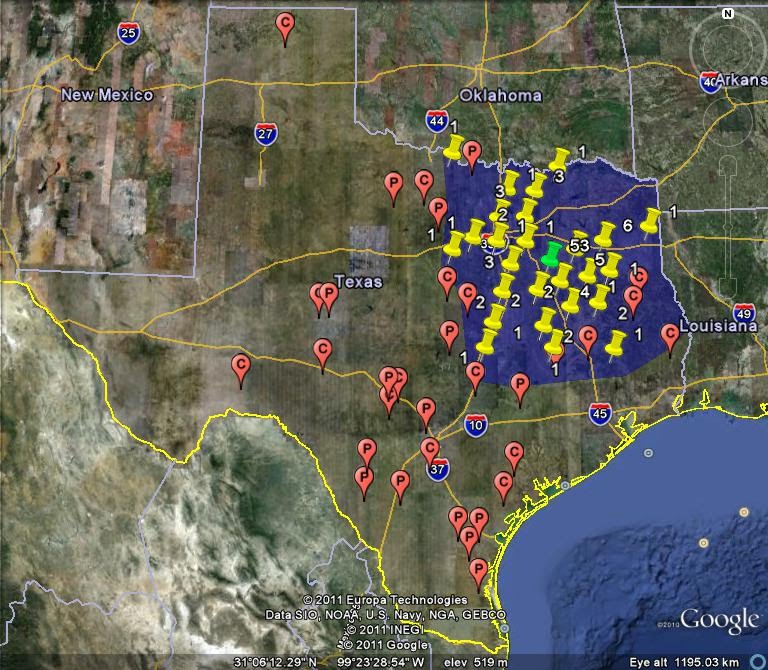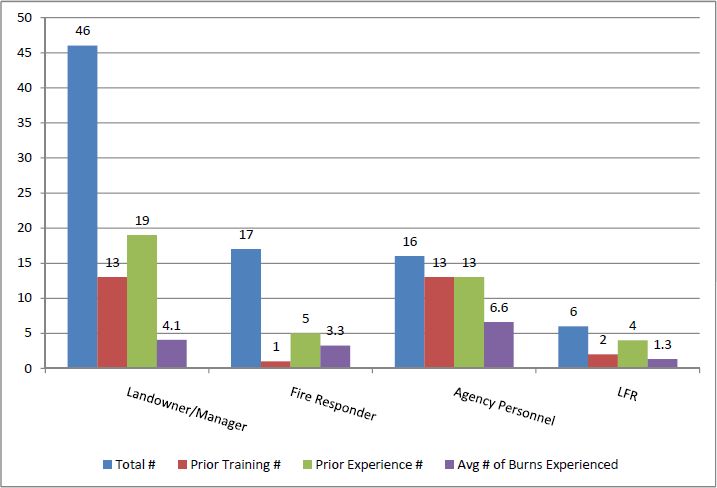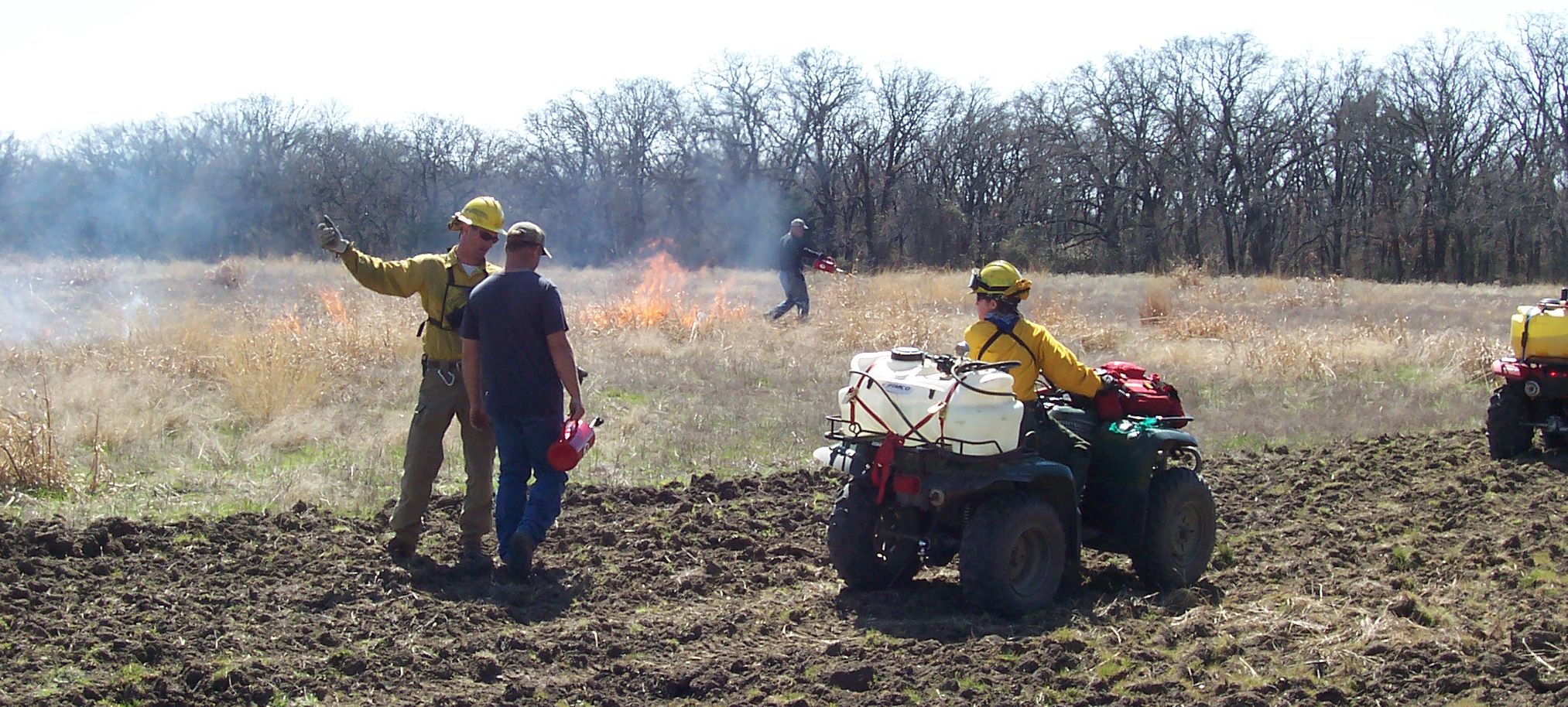Journal of the NACAA
ISSN 2158-9429
Volume 4, Issue 1 - June, 2011
Introducing the Concept of Prescribed Fire as a Natural Resource Management Tool in a Non-Traditional Burning Area of Texas
- Scasta, J.D., Navarro County Extension Agent - Agriculture and Natural Resources, Texas AgriLife Extension Service
Hanselka, C.W., Professor Emeritus and Retired Extension Rangeland Specialist, Texas AgriLife Extension Service
Hart, C.R., Professor and Extension Rangeland Specialist, Texas AgriLife Extension Service
ABSTRACT
The application of prescribed fire can be an effective natural resource management tool and assist in mitigating wildfire danger. North-east Texas is an area where landowners have not typically utilized prescribed fire even though they are dealing with natural resource issues that fire could remedy. Issues such as brush encroachment, wildfire danger and habitat restoration are widespread. A 6.5 hour workshop was held in January 2011 in Navarro County to provide technical training to landowners, managers, agency personnel and fire responders. The workshop was attended by 108 participants representing 95,492 total unique acres (71,541 private acres and 23,951 public acres) in 27 counties in north-east Texas. Participants were surveyed using retrospective post evaluations for changes in knowledge, perceptions and impact. When asked if the training would assist in applying future prescribed burns, 90.8% indicated it would. Eleven participants expressed an interest in week-long certification training. Since the training, 3 landowners in Navarro County have conducted 4 prescribed burns on 127 acres. This training sought to facilitate communication between stakeholders and equip landowners and managers with skills to apply prescribed fire as a natural resource management tool.
Introduction
The application of prescribed fire can be an effective natural resource management tool and mitigate wildfire danger. Many of the plant and animal species associated with rangeland prairie ecosystems (example: little bluestem (Schizachyrium scoparium) and bobwhite quail (Colinus virginianus)) are adapted to fire. Before the settlement of European man in North America, fire was an active disturbance on rangelands (White and Hanselka, 2000). Native american tribes and lightning served as ignition sources for wildfires (Ohlenbusch and Hartnett, 2000). These types of prairie ecosystems are considered to be fire dependent and prescribed fire may be an important component of habitat restoration and ranch management. North-east Texas is defined for this report as the region south of the Red River, west of Louisiana-Texas state line, east of Highway 281 and 50 miles north of Interstate 10 (Figure 1). This area should be considered a “non-traditional” area in terms of prescribed burning as prescribed fire is a tool that is not commonly utilized in this region. Reasons for the lack of prescribed fire applications in the region are not exactly known but may relate to the following: land fragmentation, land use, urban development, public perception, etc. However, there are numerous natural resource issues in the region that would benefit from the application of prescribed fire (brush encroachment, habitat management, native grass restoration, wildfire mitigation, etc). There are currently 8 prescribed burning associations in Texas (with several newer groups organizing) and none are located in this portion of the state (TPWD, 2009). Proper technical training is needed to equip stakeholders if prescribed fire is to be applied in this region of Texas. Training must focus on proper prescriptions and planning for safe and effective implementation of prescribed burns (White and Hanselka, 2000).

Map Key
Purple area represents 'North-east Texas'
Yellow markers indicate program participants home location
Green marker indicates program location and number of local participants
Red P indicates TDA Certified Private Burn Managers home location
Red C indicates TDA Certified Commercial Burn Managers home location
Materials and Methods
Texas AgriLife Extension Service coordinated an introductory prescribed burning workshop in January 2011 in Corsicana, TX. Corsicana is the county seat of Navarro County which is centrally located in north-east Texas. Promotion of the program was initiated by Texas A&M AgriLife Communications and various partnering agencies. The workshop targeted landowners, elected officials, fire responders and agency personnel. The workshop also aimed to initiate communication and collaboration between stakeholders (for example, between landowners and volunteer fire departments). Topics covered fire effects, fire behavior, history, policy, liability, planning, conducting the burn, fuel, weather and equipment. The training brought together a wide range of local, state and federal agencies to assist in educating stakeholders. Cooperating partners included: Texas Forest Service, Texas Department of Agriculture, United States Department of Agriculture – Natural Resource Conservation Service, United States Army Corps of Engineers, National Weather Service, Texas Parks and Wildlife, Navarro County Office of Emergency Management and Navarro Mills Volunteer Fire Department. A demonstration burn was prepped but the day of the training fire weather conditions were not within prescription. Participants were walked through the weather and condition assessment and instructed on the ‘Burn/No Burn’ decision. A ‘No Burn’ decision was made and offered the most critical teaching point of the workshop. If fire weather and environmental conditions are not within prescription of the burn you should not proceed, regardless of committed resources or personal desires. In lieu of the ‘No Burn’ decision, a discussion on hand tools, PPE, ignition, spray units and response vehicles was expanded. Workshop participants then viewed a video of a prescribed burn and were talked through the types of ignition and conduction of the actual burn. The demonstration burn was intended to be re-scheduled for a later date when conditions were more appropriate. Unfortunately, shifting local policies and available burn days put the priority on actually conducting burns on private landowner properties.
Results
The workshop was attended by 108 people representing 27 counties located in north-east Texas. The training was 6.5 hours in length and resulted in 702 contact hours. Continuing Education Units (CEU’s) were offered for Certified Professionals in Range Management (CPRM) and Texas Department of Agriculture (TDA) Pesticide Applicator License Holders. Program participants were provided with a manual of all referenced prescribed burning materials. Participants were evaluated with a retrospective post survey to assess knowledge, perceptions and adoption of prescribed burning. The survey was completed by 87 of the 108 participants (for a response rate of 80.5%). Participants were asked to describe themselves and they identified as follows: 46 Landowners or Managers (52.8%), 17 Fire Responders (19.5%), 16 Agency Personnel (18.3%), 6 Landowner AND Fire Responder (LFR’s) (6.8%) and 2 Elected Officials (2.2%). Fire Responders represented 9 Volunteer Fire Departments and 1 Municipal Fire Department. Participants were asked about previous prescribed burning training and 57 (65.5%) indicated that they had no previous prescribed burning training versus 29 (33.3%) that indicated they had participated previously in prescribed burning training.
The ‘previous burning training’ data was then correlated with participant identification:
- 13 Landowners or 28.2% of Landowners had training (versus 71.8% that did not)
- 13 Agency Personnel or 81.3% of Agency Personnel had training (versus 18.7% that did not)
- 2 LFR’s or 33.3% of LFR’s had training (versus 66.7% that did not)
- 1 Fire Responder or 5.8% of Fire Responder’s had training (versus 94.2% that did not)
Participants were asked about previous prescribed burning experience and 45 (51.7%) indicated that they had no previous prescribed burning training versus 42 (48.2%) that indicated they had participated previously in a prescribed burn.
The ‘previous burning experience’ data was then correlated with participant identification:
- 19 Landowners or 41.3% of Landowners had burn experience (versus 58.7% that had none) with an average of 4.05 burns per experienced Landowner
- 13 Agency Personnel or 81.3% of Agency Personnel had burn experience (versus 18.7% that had none) with an average of 6.61 burns per experienced Agency Personnel
- 4 LFR’s or 66.6% of LFR’s had burn experience (versus 33.3% that had none) with an average of 1.33 burns per experienced LFR
- 5 Fire Responder or 29.4% of Fire Responder’s had burn experience (versus 70.6% that had none) with an average of 3.25 burns
Figure 2: Program Participant Data by Identification, Number, Prior Training, Prior Experience and Average Number of Burns

Participants were evaluated for a change in knowledge of various aspects of prescribed burning through the use of a retrospective post survey (Table 1). This type of survey is a self-reported analysis before and after a program. The following Likert scale was used: 1=Poor, 2=Fair, 3=Good, 4=Excellent. Percent Change was calculated using the following formula: [(After-Before)/Before]*100
Table 1: Percent Knowledge Increase in Understanding of...
| Percent Change | Knowledge Parameter Evaluated |
| 87.6% | ...laws and regulations related to prescribed burning (2.28 Before vs. 3.52 After) |
| 67.7% | ...aspects of planning a prescribed burn on your land (2.05 Before vs. 3.43 After) |
| 54.9% | ...equipment needed to conduct a prescribed burn (2.27 Before vs. 3.51 After) |
| 54.6% | ...safety procedures for conducting prescribed burns (2.28 Before vs. 3.52 After) |
| 46.1% | ...fire weather and its impact on fire behavior (2.40 Before vs. 3.50 After) |
| 40.8% | ...the importance of prescribed fire to mitigate wildfire and manage natural resources (2.53 Before vs. 3.56 After) |
Participants were asked to rank in importance the value or benefit of prescribed burning. Items were ranked from 1 to 5 with 1 being the most important. Sixty-three participants responded to this question (Table 2).
Table 2: Participant Perception of Values/Benefits of Prescribed Fire
| Ranking | Value/Benefit of Prescribed Fire | Average Ranking |
| 1st | Brush management | 2.51 |
| 2nd | Enhance Grass Production | 2.73 |
| 3rd | Wildlife Habitat Management | 2.79 |
| 4th | Maintain Native Rangeland | 3.43 |
| 5th | Mitigate Wildfire Danger | 3.47 |
The participants represented 95,492 total unique acres that they owned or managed. Of those 95,492 total unique acres, 71,541 acres were private lands and 23,951 were public lands. The average land unit reported was 1,702 acres. Participants were then evaluated on how many acres they desired to burn in the next two years. Participants indicated they desired to burn 15,572 total unique acres over the next two years of which 9,662 was private and 5,910 was public. The average land unit reported to be burned was 322 acres. Participants expressing a desire to burn represented 75.7% (53 of 70 unique acreage reports) of participants OR 24.3% did not express a desire to burn any acreage within the next two years.
When participants were surveyed for desire for future training on prescribed burning, 71 said ‘Yes’ (81.6%) versus 9 ‘No’ and 7 that did not respond. Eleven participants indicated that they would like to participate in a week long certified prescribed burn manager training (representing 5 Landowners/managers, 3 Agency Personnel, 2 Fire Responders and 1 LFR). Participants were also asked if this training would assist them in applying prescribed burns in the future and 79 said ‘Yes’ (90.8%) versus 2 ‘No’ and 6 that did not respond.
Participants were also surveyed informally at the training and the following comments were documented:
Landowner Participant- “We need more burning and more classes. I am interested in the week-long, certified prescribed burn manager training”
Volunteer Fire Department Chief Participant - “The severity of the wildfires that we have been responding to has increased over time. In the past we could respond with just one truck but nowadays we need multiple trucks and a tanker unit. If we can get landowners to adopt prescribed burning we can reduce the fuel loads and the severity of wildfires.”
Agency Personnel Participant -“This training has been one of the best landowner workshops I have been a part of. The expertise of the speakers and presentation of the technical information was excellent”
Conclusion
The application and utilization of prescribed burning is often a controversial topic and one that should be approached with professionalism and precision. Emphasis on the planning and preparation for a prescribed burn is a critical step in achieving the goals of a burn (Hanselka, 2009). Political decisions, such as the implementation of burn bans, can often inhibit the ability to burn and it is critical to involve policy makers in discussions. Enabling landowners and managers to safely and effectively use prescribed fire requires training opportunities and technical assistance. It also requires a focus on cultural and sociological impacts and efforts that will foster an appreciation of fire as a management tool.
This training sought to bring together key stakeholders and develop the conduit to communication and teamwork as it relates to implementing prescribed fire. To date, 3 landowners in Navarro County have safely and effectively conducted 4 prescribed burns on 127 acres with assistance from state agencies, private organizations and local volunteer fire departments. This can largely be associated with landowner initiative, awareness and training (like the program described here), technical assistance on the ground from groups like Texas Parks and Wildlife and logistical support from volunteer fire departments.
For educators facing similar needs it is important to consider a couple of points from this program: multi-agency involvement leverages resources, on-the-ground technical assistance is critical for the actual application of prescribed burns and continuing education will be needed in the future (multiple years). Evalution of future adoption of prescribed fires and monitoring the impact on rangeland plant communities will be prudent in enhancing the understanding of this natural resource management tool.
Figure 3: Implementing a Prescribed Burn in Navarro County in March 2011

In recent years, the formation of prescribed burning cooperatives or associations has been a powerful method for leveraging resources and organizing burning efforts for private landowners (Taylor, 2005). When we evaluate the location of burn associations in the state of Texas and where participants came from for the workshop it is obvious that there is a gap in resources regionally. There are an estimated 85 counties that are in a prescribed burning association and only 1 participant that attended the workshop resided in one of those counties. Another way to evaluate trained prescribed burning resources is to consider the geographic location of Texas Department of Agriculture Prescribed Burning Board (established 1999) Private & Certified Burn Managers across the state (TDA, 2011). There are currently 36 Private Burn Managers in 15 counties. None of the Private Burn Managers are located in counties represented by workshop participants. There are currently 26 Commercial Burn Managers in 18 counties. Only 1 of the Private Burn Managers is located in a county represented by workshop participants. The Texas Department of Agriculture licenses both levels of burn managers in 5 areas of the state. North-East Texas as described in this report is for the most part represented by Region 3 “Blackland Prairie” and “Oak Woods & Prairie” and Region 4 “Piney Woods”. Of the Private Burn Managers there is only 1 licensed to burn in Region 3 and O in Region 4. Of the Commercial Burn Managers there are 10 licensed in Region 3 and 17 licensed in Region 4. This training exhibited the interest (108 participants representing 95,492 total unique acres) in this region of the state regarding prescribed fire and the need for technical training.
References
Hanselka, C.W. 2009. Planning a Prescribed Burn. Texas AgriLife Extension Service Publication E-460. Texas A&M University System, College Station, TX.
Ohlenbusch, P.D. and D.C. Hartnett. 2000. Prescribed Burning as a Management Practice L-815. Kansas State University Agricultural Experiment Station and Cooperative Extension Service.
Taylor, C.A. 2005. Prescribed Burning Cooperatives: Empowering and Equipping Ranchers to Manage Rangelands. Rangelands Feb 2005 : Vol. 27, Issue 1, pg(s) 18-23
Texas Department of Agriculture (TDA) Prescribed Burning Board. Certified Prescribed Burn Managers Report. http://www.agr.state.tx.us/agr/main_render/0,1968,1848_20399_0_0,00.html?channelId=20399
Texas Parks and Wildlife (TPWD). 2009. Prescribed Burning Associations in Texas. Texas Parks and Wildlife Department. http://www.tpwd.state.tx.us/landwater/land/technical_guidance/burn/
White, L.D. and C.W. Hanselka. 2000. Prescribed Range Burning in Texas. Texas AgriLife Extension Service Publication E-37. Texas A&M University System, College Station, TX.
